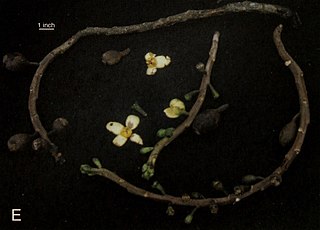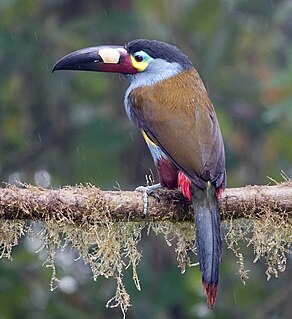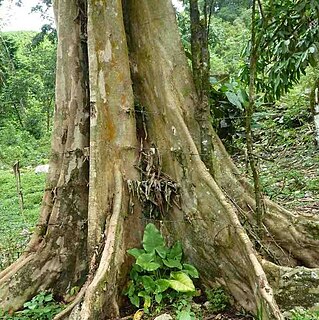
The Lecythidaceae comprise a family of about 20 genera and 250–300 species of woody plants native to tropical South America, Africa, Asia and Australia.
Grias cauliflora, the anchovy pear, is a fruit native to Jamaica, Central America, and Colombia. It is often found near rivers or marshes in large colonies. It grows on the evergreen tree Grias cauliflora of the Lecythidaceae family.

Grias is a genus of flowering plants in the family Lecythidaceae, described by Linnaeus in 1759. It is native to northwestern South America, Central America, and Jamaica.

The dark long-tongued bat is a species of bat from South and Central America. It was formerly considered monotypic within the genus Lichonycteris, but is now recognized as one of two species in that genus, along with the pale brown long-nosed bat. It is small species of bat, with adults weighing 6–11 g (0.21–0.39 oz) and having a total length of 46–63 mm (1.8–2.5 in).
The moon striped mouse or Ruwenzori hybomys is a species of rodent in the family Muridae. It is found in Democratic Republic of the Congo, Rwanda, and Uganda. Its natural habitat is subtropical or tropical moist montane forests. It is threatened by habitat loss.

Cariniana is a genus of trees in the family Lecythidaceae, first described as a genus in 1842. The entire genus is native to South America. Many are of importance for timber production. Species of this genus may be known commonly as jequitibá.
Grias colombiana is a species of woody plant in the family Lecythidaceae. It is found only in Colombia.

Grias longirachis is a species of woody plant in the family Lecythidaceae. It is found only in Ecuador. Its natural habitats are subtropical or tropical moist lowland forests and subtropical or tropical moist montane forests.
Grias multinervia is a species of woody plant in the family Lecythidaceae. It is found in Colombia and Ecuador.
Gustavia dodsonii is a species of woody plant in the family Lecythidaceae. It is found only in Ecuador. Its natural habitats are subtropical or tropical moist lowland forests and subtropical or tropical moist montane forests. Its most remarkable feature are its seeds, which can measure up to 2.9 inches in length by up to 2.25 inches (58mm) in diameter.

The black-tailed trainbearer is a species of hummingbird in the family Trochilidae. It is found between 2500 and 3800m in Colombia, Ecuador, and Peru. Its natural habitats are subtropical or tropical moist montane forest, subtropical or tropical high-altitude shrubland, and heavily degraded former forest.

The semiplumbeous hawk is a species of bird of prey in the family Accipitridae. It is found in Colombia, Costa Rica, Ecuador, Honduras, and Panama. Its natural habitat is subtropical or tropical moist lowland forests.

The plate-billed mountain toucan is a species of bird in the family Ramphastidae. It is native to the west slope of Ecuador and extreme southern Colombia, where it lives in the high-altitude humid mountain forests of the Andes. It is also known as the laminated hill-toucan, laminated mountain-toucan, and plain-billed mountain-toucan.
Rinorea haughtii is a species of plant in the Violaceae family. It is endemic to Colombia.

The Sauro lizardfish(Synodus lacertinus) is a type of lizardfish that lives mainly in the eastern Pacific Ocean.

Lecythis zabucajo, the sapucaia or paradise nut, is a large nut-producing tree occurring in the Guianas, Suriname, Venezuela, Ecuador, Honduras and Brazil, and which distribution range is much the same as that of the greater spear-nosed bat. Although not singling out Lecythis zabucajo, Jacques Huber noted in 1909 that fruit bats played the most important role in seed dispersal in Amazonian forests. The quality of its nuts led to the species' being introduced to numerous tropical countries, notably Trinidad, where it has flourished. The nuts are a valuable food resource and yield oil suitable for cooking and domestic use.
Salacca affinis, also known as red salak, red snakefruit salak, red snakefruit, buah ridan salak, buah ridan, linsum, salak hutan, buah manau, kelubi, buah rotan, and ridan, is a flowering shrub in the family Arecaceae. The specific epithet (affinis) comes from Latin "ad finis", meaning "at the boundary", and refers to its resemblance with the congener species Salacca zalacca.

Licania platypus, also known as sun sapote, sansapote, sonzapote, sunzapote, sungano, zapote cabelludo, sapote, sangre, zapote amarillo, zapote borracho, zapote cabello, zapote de mico, zapote de mono, mesonsapote, mezonzapote, cabeza de mico, caca de nino, sonza, sunza, zunza, chaute jolobob, urraco, chupa, and monkey apple, is a flowering tree in the family Chrysobalanaceae.

Symphyotrichum molle is a species of flowering plant in the aster family (Asteraceae) endemic to the Bighorn Mountains of Montana and Wyoming in the United States. Commonly known as soft aster, it is a perennial, herbaceous plant that ranges from 30 to 60 centimeters in height.
Lecythis poiteaui (Lecythidaceae) of the Guianas and eastern Brazil, commonly called Jarana Amarela, is a rainforest tree of non-flooding forests, reaching canopy-height. The leaves are deciduous, elliptic, to 10.5 inches long by up to four inches wide, with crenulate edges. Inflorescences unbranched racemes up to 12 inches (30 cm) in length, usually at the tip of branches with 2 to 7 widely spaced, oddly shaped creme de minthe or white flowers, having around 1,000 stamens each. Fruit globose 1.25 inches by one inch (2.5 cm) with 4 to 6 brown, aril-covered seeds in each.












